Physical Address
304 North Cardinal St.
Dorchester Center, MA 02124
Compression of the sciatic nerve by the piriformis muscle is noted in the pelvis.
The L4, L5, S1, and S2 nerve roots give contributions to the sciatic nerve. As the nerve exits the greater sciatic foramen, it is composed of the tibial and peroneal divisions, enclosed by a common nerve sheath.
The sciatic nerve descends anteriorly to the piriformis muscle in the pelvis and courses downward in the thigh. In the distal third of the thigh, the tibial and peroneal divisions separate into the tibial nerve and the common peroneal nerve (see eFig. 35-1 ).

The sciatic nerve innervates the posterior muscles of the thigh and provides sensory and motor functions below the knee. The tibial division of the sciatic nerve innervates the hamstring muscles. At the level of the hip, the tibial division also innervates all of the muscles of the posterior compartment of the leg and plantar foot muscles. The common peroneal nerve innervates the muscles of the anterior and lateral compartment of the leg and the dorsum of the foot. It also provides sensation to the dorsal foot.
Entrapment of the sciatic nerve is most often iatrogenic related to total hip replacements/revisions, causing trauma to the nerve.
Piriformis syndrome is a well-known cause of sciatic nerve entrapment most often related to hypertrophy, inflammation, spasticity, or irritability of the piriformis.
Hypertrophy of the piriformis muscle can cause crowding of the greater sciatic foramen, resulting in compression of the sciatic nerve. This may be seen in exaggeration of the lumbar lordosis, hip flexion deformities, or overstretching.
Spasm, inflammation, or degeneration of the piriformis muscle as well as bursitis from sacroiliac disease can cause a sciatic nerve neuropathy.
Cerebral palsy can lead to increased spasticity of the piriformis muscle.
Trauma to the gluteal or sacroiliac regions can cause hematoma or fibrous adhesions that can cause crowding of the greater sciatic foramen.
Compromise of the blood supply to the sciatic nerve produces local nerve ischemia.
Anatomic variations of the piriformis muscle can produce entrapment. The piriformis muscle may be pierced by the sciatic nerve or by the peroneal division of the sciatic nerve and can become compressed during muscle contraction (see eFig. 35-1 ).
Sciatic, leg, or buttock pain
Can exclude the presence of other causes located in the pelvis compressing the sciatic nerve, such as tumors, cysts, and lumbar discogenic disease ( Fig. 35-1 ).
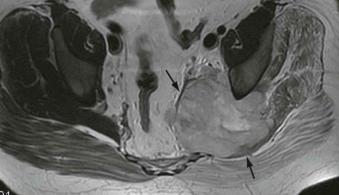
Asymmetry in piriformis muscle size between symptomatic and asymptomatic sides ( Fig. 35-2 ).
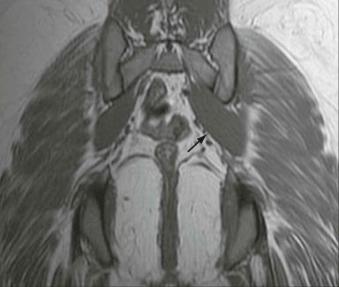
Hypertrophy or atrophy of the piriformis muscle
Intramuscular location of the sciatic nerve or one of its divisions within the piriformis muscle
Increased signal in the piriformis muscle and the sciatic nerve
Can diagnose and be used to aspirate or perform a biopsy on other lesions located in the pelvis compressing the sciatic nerve, such as cysts ( Fig. 35-3 ).

Other possible causes of pain in the lower back, buttock, hip, or thigh—such as tumors, lumbar disk herniation, or lumbar stenosis
Entrapment of the femoral nerve at the level of the pelvis underneath the inguinal ligament is the cause of iliacus syndrome. Under the inguinal ligament, there is a rigid tunnel called the lacuna musculorum. The roof of this tunnel is formed by the iliopectineal arch and the inguinal ligament. The floor of this tunnel is formed by the iliac bone and iliopsoas muscle.
The L2, L3, and L4 nerve roots of the lumbar plexus provide contributions to the femoral nerve. It supplies motor innervation to the anterior muscle compartment of the thigh (except for the tensor fascia lata) and sensation to the anterior and distal medial thigh, anteromedial knee, and medial leg and foot.
Iatrogenic injury can occur from procedures in the region, such as pelvic surgery, hip surgery, gynecologic procedures (e.g., hysterectomy), femoral artery catheterization, and arterial bypass procedures.
Trauma also can cause neuropathy (e.g., hip/pelvic fractures, gunshot wounds, lacerations, hematoma of the iliacus muscle).
Decreased knee extension, decreased hip flexion, difficulty climbing up stairs and rising from a sitting position
Atrophy of the muscles in the anterior compartment of the thigh
Decreased sensation in the anterior and medial lower thigh and medial knee, leg, and foot
Absence of the knee jerk reflex
Evidence of mass effect from tears of the iliacus or iliopsoas muscle, hematomas ( Fig. 35-4 ), and posttraumatic pseudoaneurysm of the iliac vessels
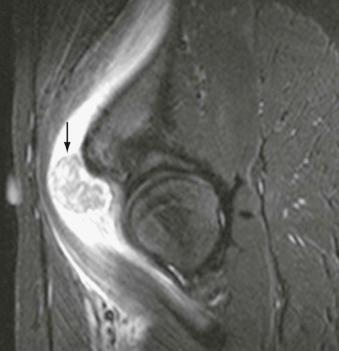
Denervation edema of the quadriceps muscle
Lumbar plexus and L4 radiculopathy
Saphenous nerve entrapment may occur within the adductor canal where its superficial location can predispose it to trauma (contusions and lacerations).
Saphenous nerve is purely a sensory nerve that originates from the femoral nerve just distal to the inguinal ligament and courses into the adductor canal. It runs distally in an oblique manner, adjacent to the femoral artery and vein and deep and parallel to the sartorius muscle. It supplies sensation to the medial thigh, leg, and foot ( Fig. 35-5 ).

Trauma can cause contusions and lacerations that can affect the nerve due to its superficial location in the adductor canal.
Iatrogenic injury can occur (e.g., knee surgery/arthroscopy).
Patients with posterolateral instability can develop nerve injury, thought to be related to stretching of the nerve.
Decreased sensation in the medial thigh, leg, and foot
Because the nerve is sensory, no muscle denervation changes are seen.
Nerve displacement by space-occupying lesions is the most common finding (e.g., meniscal cyst, ganglion cyst) ( Fig. 35-6 ).
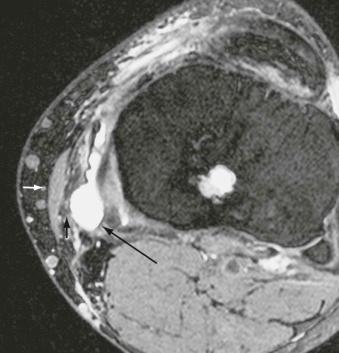
Lumbar plexus and L4 radiculopathy
The L2, L3, and L4 roots give contributions to the obturator nerve, which is formed within the substance of the psoas muscle. The nerve descends inferiorly and anteriorly along the iliopectineal line into the lesser pelvis. It exits the pelvis at the obturator foramen through the obturator canal and then pierces the obturator externus muscle ( Fig. 35-7 ).
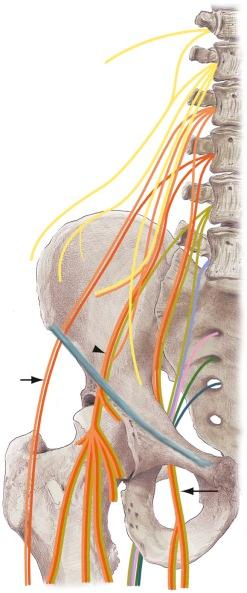
The obturator nerve innervates the medial thigh muscles. It gives off anterior and posterior branches before exiting the pelvis.
The anterior branch descends posteriorly to the pectineus and adductor longus muscles and anteriorly to the obturator externus and adductor brevis muscles. It innervates the hip joint and provides motor innervation to the gracilis, adductor brevis, adductor longus, and pectineus muscles. It also provides sensation to the medial side of the thigh.
The posterior branch descends posteriorly to the adductor brevis and anteriorly to the adductor magnus muscles. It innervates the knee joint and provides motor innervation to the obturator externus, adductor component of the adductor magnus muscle (hamstring component supplied by the sciatic nerve), and the adductor brevis muscle.
Pelvic and acetabular fractures
Iatrogenic compression of the nerve during total hip replacement
Myositis ossificans
Posttraumatic hematomas
Less common: pelvic tumors, obturator hernia, genitourologic surgery, prolonged lithotomy position, fascial thickening, and osteitis pubis
Obturator neuropathy in athletes is thought to be secondary to adhesions of the fascia of the adductor brevis muscle secondary to chronic adductor tendinopathy, resulting in entrapment of the nerve at the obturator foramen.
Pain in the groin or medial thigh
Weakness of the adductor muscle, resulting in a wide gait (due to unopposed hip abduction)
Alterations in size and signal of the nerve
Mass effect from space-occupying lesions, such as soft tissue or osseous pelvic tumors
Denervation edema or atrophy of the medial thigh muscles
The L2 and L3 nerve roots give contributions to the lateral femoral cutaneous nerve, which is a purely sensory nerve.
The lateral femoral cutaneous nerve travels laterally under the psoas muscle and across the iliacus muscle, exiting the pelvis underneath the inguinal ligament just medial to the anterior-superior iliac spine and then pierces the fascia lata a few centimeters below the anterior-superior iliac spine. The cutaneous nerve divides into an anterior branch, which innervates the skin of the anterolateral thigh, and a posterior branch, which innervates the skin of the posterolateral thigh ( Fig. 35-8 ).
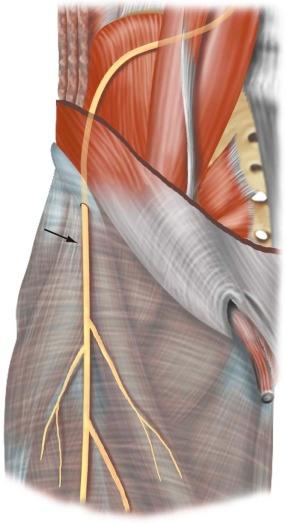
Entrapment of the nerve occurs at two sites, as follows:
Under the inguinal ligament, where the nerve makes a sharp turn as it bends around the anterior-superior iliac spine
As the nerve pierces the fascia lata a few centimeters below the anterior-superior iliac spine
Trauma such as avulsion fracture at the anterior-superior iliac spine
Pelvic and retroperitoneal tumors causing compression of the nerve
Surgical procedures (e.g., spine surgery, acetabular fracture fixation, pelvic osteotomy)
Posttraumatic neuroma after pelvic injury
Prolonged lithotomy position
External compression of the nerve by seat belts, weight gain, tight clothing
Extended periods of standing, causing increased tension on the fascia lata muscle
Leg-length discrepancy
Scoliosis
Also called meralgia paresthetica due to the symptoms of burning, pain, numbness, tingling, and decreased sensation along the lateral aspect of the thigh
Alteration of signal and size of the nerve at the site of entrapment (see eFig. 35-2 )
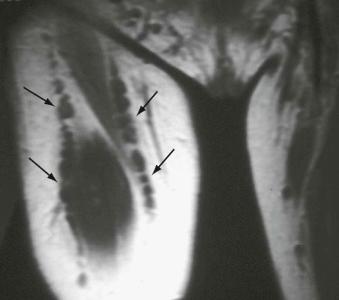
Space-occupying lesions causing mass effect on the nerve
Because the nerve is purely sensory, muscle denervation signal changes are not seen.
Become a Clinical Tree membership for Full access and enjoy Unlimited articles
If you are a member. Log in here